Name Adam des | ||
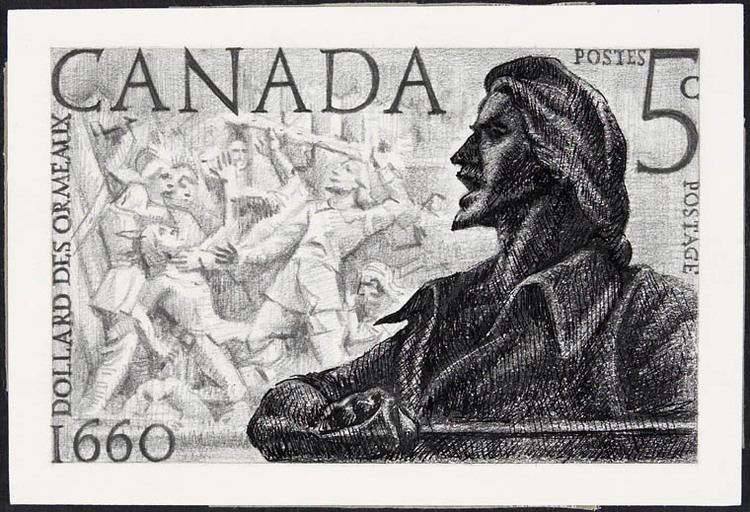 | ||
Died May 21, 1660, Saint-Andre-d'Argenteuil, Quebec, Canada | ||
Adam Dollard des Ormeaux, (July 23, 1635 – May 21, 1660), is an iconic figure in the history of New France. Arriving in the colony in 1658, Dollard was appointed the position of garrison commander of the fort of Ville-Marie (now Montreal), a title that he shared with Pierre Picoté de Belestre.
Contents
- Dollard in New France
- Expedition west and the Battle of Long Sault
- Representations of Dollard as a Cultural Figure in French Canadian History
- English History
- The Arts
- Public Statues
- Holiday
- Toponymy
- References
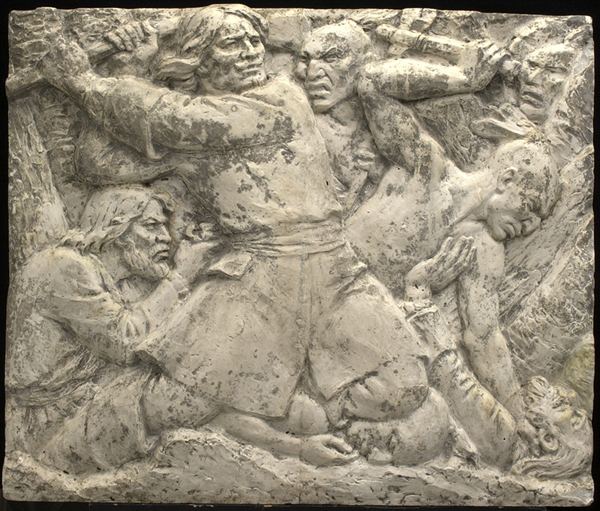
In the spring of 1660, Dollard led an expedition up the Ottawa River to wage war on the Iroquois. Accompanied by seventeen Frenchmen, Dollard arrived at the foot of Long Sault (near present-day Carillon, Quebec) on May 1 and settled his troops at an abandoned Algonquin fort. He was then joined by forty Huron and four Algonquin allies. Vastly outnumbered by the Iroquois, Dollard and his companions died at the Battle of Long Sault somewhere between May 9 and May 12, 1660. The exact nature or purpose of Dollard's 1660 expedition is uncertain; however, most historians agree that Dollard set out to conduct a "petite guerre" (ambush) against the Iroquois, in order to delay (or avoid altogether) their imminent attack on Ville-Marie. For these reasons, Dollard is regarded as one of the saviors of New France.
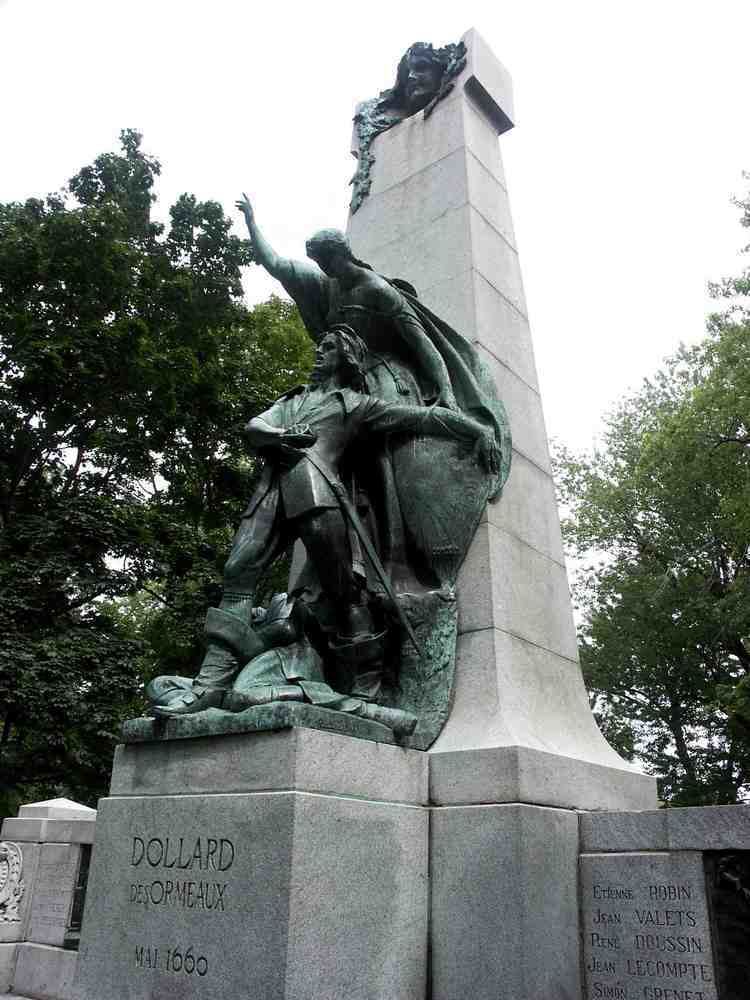
Dollard in New France
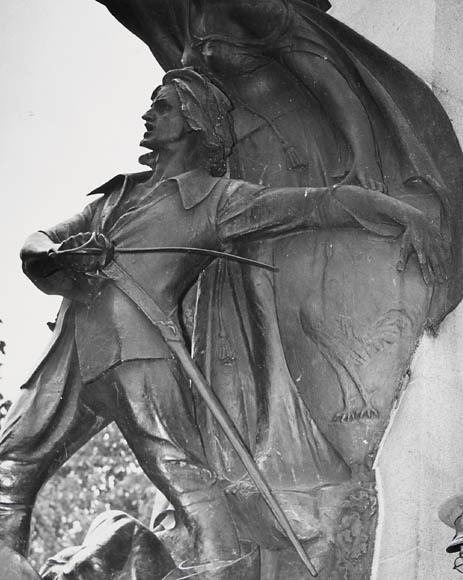
Dollard was born in Lumigny-Nesles-Ormeaux, France in 1635. At the age of 23, he settled in Montreal and took up a career in the military. Aside from some military experience, nothing is known of his activities prior to his arrival in Canada. In Ville-Marie, Dollard had attained a rather positive reputation. In Histoire de Montréal, François Dollier de Casson portrays Dollard as "a youth of courage and of good family" and in the Jesuit Relations, Dollard is described as a "man of accomplishment and generalship". Most importantly, Dollard had gained the trust of Paul de Chomedey, Sieur de Maisonneuve, who authorized Dollard’s expedition to Long Sault.
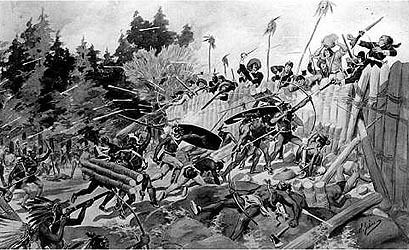
There is little verifiable evidence regarding Dollard's reason for being in Canada, but it is possible he was contemplating life as a settler in the colony. Tellingly, by the end of 1659, Maisonneuve gave him a piece of land comprising 30 arpents (10 hectares). Upon Dollard’s death, Pierre Picoté de Belestre inherited his land.
Expedition west and the Battle of Long Sault
Against the advice of seasoned Aboriginal fighters, Dollard got the support of the governor of Montreal, Paul Chomedey de Maisonneuve, to organize an expedition west. The group comprised about 17 volunteers who had little or no experience in Aboriginal warfare. After a 10-day canoe trip up the Ottawa River, they set up camp not far from Carillon, Quebec, in a former stockade. They were soon surrounded by about 700 Iroquois and after a siege lasting several days, they were all killed or captured in what became known as the Battle of Long Sault. For reasons unknown, the Iroquois did not continue east to capture Ville-Marie. The events were witnessed by about 40 Huron allies who at times had joined the colonists in the stockade and at other times had harried the Iroquois from outside. According to some scholars, the battle so weakened the Iroquois they canceled their planned attack on Ville-Marie (Montreal) and returned home. For over a century Dollard des Ormeaux became a heroic figure in New France, and Quebec, as he exemplified selfless personal sacrifice, as well as martyrdom for the church, and for the colony. Agreements on the validity of this interpretation are debatable.
The reason for Dollard and his companions for ambushing the Iroquois is up to debate. Tradition holds that Dollard anticipated an Iroquois attack on Ville-Marie (Montreal). In response, he amassed a small force of seventeen Frenchmen, four Algonquins, and about forty Hurons. They fought to the death and saved Ville-Marie from invasion. There are many scholars who claim his reasons were different. According to André Vachon, some historians claim that Dollard was in debt and thereby sought to steal the furs from the Iroquois who were returning from their winter's hunt. This theory is often criticized. One of such criticisms lies on the fact that Paul Chomedey de Maisonneuve approved of this expedition, which implied that the goals of the expedition were justified on more civil service or military grounds. The more likely reason relates to the reasons given by the traditional narrative. However, a more historical analysis of the context of late 17th century New France is better for establishing a more concrete cause for this mission.
Many historians, such as John A. Dickinson, argue that not enough attention has been given to considerations of indigenous culture in this debate. The Iroquois and the Huron at this time were in conflict with one another. Prior to 1660, the Iroquois wiped out a great many Hurons leaving very few of them in the area of Ville-Marie. Moreover, indigenous warfare, among other things, involves codes of honor. Therefore, as some historians argue, the forty Huron who went up the Ottawa River to intercept the Iroquois did so to fight them because of issues involving honor. The reasons for the Iroquois not to attack Montreal can simply be that the Iroquois did not have any immediate conflict with the French.
The location of the battle is a topic of intense controversy. Traditionally, the battle was fought along the Ottawa River near Carillon, Quebec. This location is based on nationalistic traditions on the part of Quebec historians. Supporters of this location also refer to the countless texts written after the event and for many years after which maintain this tradition. However, other scholars place the event on the northern side of the Ottawa River on the now Ross Farm in Ontario. The location being either in Ontario or Quebec has cultural implications. However, both sides of the debate agree that Dollard and his both French and Indigenous comrades would have taken the route following the Ottawa River since they sought to intercept the Iroquois coming back from their winter hunt. Similar to the Carillon advocates, the Ross farm advocates, in part, base their conclusions on tradition. Traditions include known battles between French and Iroquois in this area, old French inhabitants of the area placing the battle there, and also from the testimony of a Huron eyewitness to the battle. Archeological evidence is also referenced by Ross farm advocates. Archeological excavations of palisades (in which Dollard and his comrades fought in) and considerations of topography coincide with the testimonies of the Huron survivors along with other oral and written traditions.
Representations of Dollard as a Cultural Figure in French Canadian History
The first sources written concerning the Battle of Long Sault are a series of letters composed by Marie Guyart, founder of the Ursuline institute of New France, and a collection of compiled documents from various Jesuit missionaries entitled Relations. These sources, written immediately after Dollard’s death in 1660, give descriptive accounts of the battle and emphasize the dualism between Christianity and the Barbarism of the Natives. Although he is singled out as the leader in these earliest recorded stories, Dollard des Ormeaux is not the main focus of the battle.
In 1672, François Dollier de Casson wrote Histoire de Montréal. His book included a chapter dedicated solely to Dollard des Ormeaux and the Battle of Long Sault. This work marked a shift in Dollard’s personal role in the battle. In Dollier’s account, Dollard becomes a central heroic figure. He is characterized by an air of mystery and strong leadership abilities. He also occupies a more active role in the proceedings. Similar to Guyart’s account, Dollard is aligned with Christianity in opposition to the barbarism of the Natives.
These accounts of Dollard provided a basis that allowed him to develop into and be upheld as a heroic figure in French-Canadian culture, post-British conquest. These sources also set a precedent of anti-Native American sentiment surrounding the veneration of Dollard.
With the exception of a brief mention in the work of Charlevoix in the 1700s, Dollard and the Battle of Long Sault does not reappear in French Canadian writing until the 1840s. The re-emergence of the tale coincides with the union of Upper and Lower Canada and the ensuing fear that French Canadians would lose control over their rights. The story of Dollard was used by authors in this period, such as François-Xavier Garneau, to secure a space for the French in the national history of Canada. Garneau’s text emphasizes the loyalty of Dollard and his soldiers to their nation and the unity of their action.
The rise of industrialization and ultramontanism in the 1860s marked another shift in the story of Dollard. The Catholic Church had become an influential representative of French Canadian interests within the country. To provide ideal moral models, the Catholic clergy wrote versions of history with an emphasis on Christian heroes. In 1865, Étienne-Michel Faillon published L’Histoire de la colonie française au Canada which included an account of the Battle of Long Sault. Faillon’s writing places heavy emphasis on the duality between Christianity and barbarity. The language used by Faillon is aggrandizing and glorifies Dollard and his soldiers far more than previous accounts. Dollard, in Faillon’s account, becomes an ideal model of Christian morality. Faillon’s text became the canon of the Dollard story in French Canadian culture.
This attitude was perpetuated throughout the early 1900s. The writing of Lionel Groulx, for instance, portrays Dollard as a figure of French Canadian nationalism and Catholicism. Groulx’s writing, in particular, emphasizes the youth of Dollard and upholds him as a model for French Canadian children.
Since controversy has come to light surrounding the circumstances of the Battle of Long Sault, modern historians have challenged traditional visions of Dollard as a hero in Quebec culture. Notable historians on this subject include E. R. Adair and Gustave Lanctot.
English History
Dollard not only occupies a prominent position in French Canadian culture but also appears as a figure in English Canadian history. In the 1860s, Francis Parkman wrote an English account of the Battle of Long Sault. His version focuses less on Catholicism and instead uses the story as a model of continuity of European settlements in the Canadas.
The Arts
There have been tributes to Dollard des Ormeaux in Canadian poetry, theater, and literature. As a response to French marginalization throughout Canada, a lot of this work generally focuses on themes of heroism and the strength of French Canadian ancestors. The art also often explores Dollard’s martyrdom for the growth of a nation. Natives are largely absent in these bodies of work and when represented, often depicted as negative figures.
Public Statues
Holiday
In Quebec, starting during the time of the Quiet Revolution, Victoria Day became unofficially known as Fête de Dollard. In 2003, provincial legislation officially declared the date to be National Patriots' Day.
Toponymy
Dollard’s importance in Quebec culture is reflected in the province’s toponymy. According to the Quebec’s toponymy commission, the following places bear his name:
